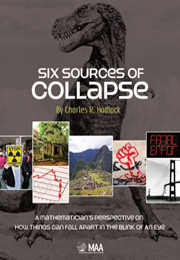 Six Sources of Collapse
Six Sources of Collapse A quick review
We started in Chapter 1 with a broad survey of types of phenomena subject to collapse, surely not all inclusive but certainly representing a wide range of subject areas, time frames, spatial dimensions, and dynamics. You may recall from Table 1.1 in that chapter that these ranged from empires to fads, galaxies to tumors, companies to civil order. There are certainly many ways to study and learn about these phenomena and about their vulnerability to collapse. These may variously include, depending on the particular subject matter: historical analysis, scientific data collection or experiments, logical or theoretical argument, expert opinion, or other methodologies. I asserted that the use of mathematical models is a particularly useful method in that it enables us to see commonalities across a wide range of cases from different subject areas and thus to get better insight on the underlying dynamics of many collapses. It has the additional advantage of offering a language that lets us depict these common dynamics efficiently and clearly in symbolic and graphical ways, as have been utilized throughout the previous chapters.
In the subsequent six chapters, we looked at six mathematical frameworks and how they might be applied to seemingly diverse areas of collapse. These are the “six sources of collapse” referred to in the title of this book and the six dimensions suggested in the title of this chapter. They include low probability events, group behavior, evolutionary processes, instability, nonlinearity, and networks. A brief summary of each is given in Table 8.1.
To save this book to your Kindle, first ensure no-reply@cambridge.org is added to your Approved Personal Document E-mail List under your Personal Document Settings on the Manage Your Content and Devices page of your Amazon account. Then enter the ‘name’ part of your Kindle email address below. Find out more about saving to your Kindle.
Note you can select to save to either the @free.kindle.com or @kindle.com variations. ‘@free.kindle.com’ emails are free but can only be saved to your device when it is connected to wi-fi. ‘@kindle.com’ emails can be delivered even when you are not connected to wi-fi, but note that service fees apply.
Find out more about the Kindle Personal Document Service.
To save content items to your account, please confirm that you agree to abide by our usage policies. If this is the first time you use this feature, you will be asked to authorise Cambridge Core to connect with your account. Find out more about saving content to Dropbox.
To save content items to your account, please confirm that you agree to abide by our usage policies. If this is the first time you use this feature, you will be asked to authorise Cambridge Core to connect with your account. Find out more about saving content to Google Drive.